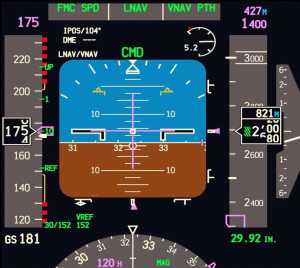 A primary flight display is an essential part of an airplane’s flight instruments. Whether narrow body or wide body, most commercial airplanes have a primary flight display. It’s located in the cockpit where it serves as an information resource for pilots. What is a primary flight display exactly, and how does it work?
A primary flight display is an essential part of an airplane’s flight instruments. Whether narrow body or wide body, most commercial airplanes have a primary flight display. It’s located in the cockpit where it serves as an information resource for pilots. What is a primary flight display exactly, and how does it work?
Overview of Primary Flight Displays
A primary flight display is an electronic display that contains information about the airplane — or, more specifically, the flight — with which it’s used. As shown in the adjacent photo, it combines instrument readings from traditional six-pack gauges. Rather than having to monitor six individual gauges, pilots can refer to the primary flight displays. The primary flight display shows the same readings but with several additions.
Most primary flight displays use either cathode-ray tube (CRT) or liquid-crystal display (LCD) technology. CRT and LCD are display technologies. CRT is an older technology that’s commonly associated with early model TVs. LCD is a newer technology that’s used in everything from TVs and computer monitors to tablets, smartphones and more. Regardless, most primary flight displays consist of either a CRT or LCD display unit.
History of Primary Flight Displays
Primary flight displays have been around for decades. They didn’t become common, however, until the mid-1980s. Around this time, most commercial airplanes were equipped with a primary flight display. Aerospace manufacturers recognized the convenience offered by these instrument displays, so they began using them in their airplanes. Primary flight displays have since become synonymous with flight instruments.
With a primary flight display, mechanical gauges aren’t needed. In the past, many commercial airplanes featured six mechanical gauges. Known as the six-pack, it provides similar information about the airplane and its flight. Primary flight displays offer an alternative solution. They use a digital display to reveal all of this information. As a result, the mechanical gauges used in six-packs aren’t needed.
Components of Primary Flight Displays
What are the components of a primary flight display? The main component, of course, is a display unit. As previously mentioned, all primary flight displays have a display unit, which is powered by either CRT or LCD technology. When turned on, the primary flight display will provide information such as the altitude, speed, turn coordinator and more.
In the middle of a primary flight display is an altitude indicator (AI). The AI reveals the pitch and roll of the airplane. As the airplane’s pitch or roll changes, the changes will be reflected on the primary flight display.



